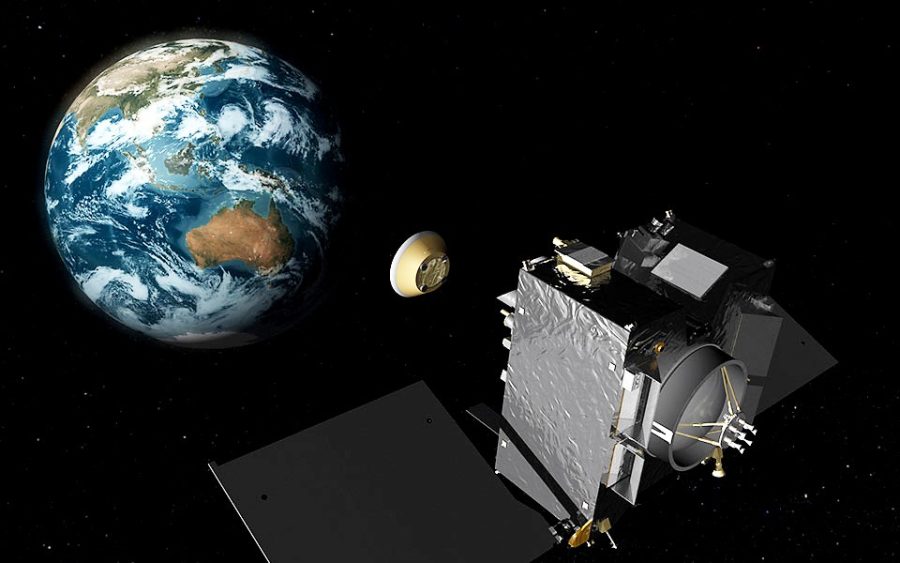A team of UA scientists plans to land a space probe known as OSIRIS-REx on a moving asteroid named Bennu. The goal of the mission is to collect samples of the asteroid’s surface material and transport them back to Earth for analysis. The $1 billion mission, funded by NASA, will span more than 7 years and enlist the help of scientists from around the world. Analysis of the asteroid will provide clues about our solar system’s past and the compounds that may have seeded life on Earth, according to the mission’s principal investigator, Dante Lauretta.
Based on a notional timeline for the mission, the following entries chronicle the journey of OSIRIS-REx as it travels to Bennu and back.
Sept. 3, 2016 — Launch
The mission will begin as an Atlas V rocket roars to life at the Kennedy Space Center near Cape Canaveral, Fla. Leaving a trail of orange flames, the launch vehicle will accelerate out of the Earth’s atmosphere and into space, where it will deploy the OSIRIS-REx spacecraft.
As the craft hurtles silently through space, it will be in constant communication with teams on the ground who will monitor everything from the craft’s speed to its thermal environment, said Edward Beshore, deputy principal investigator for the mission.
“When you go out on a hot day in Tucson, you have ways to get rid of that heat … like sweating,” he said. “It’s very hard to get rid of stored heat in a spacecraft.”
To avoid overheating, the spacecraft will “rotate like a rotisserie,” he explained, which will move the hotter parts of the craft into shadow.
Sep. 22, 2017 — Gravity assist
After a year in orbit around the sun, OSIRIS-REx will make a flyby of Earth. Earth’s gravitational field will pull the craft in close to the planet before flinging it back into space for its rendezvous with Bennu.
Aug.17, 2018 — Approach
As the craft approaches the asteroid, which travels around the sun at an average speed of 63,000 mph, it will use an array of small rocket thrusters to decelerate before entering into orbit around Bennu.
The time spent near the asteroid is the most dangerous phase of the mission, Lauretta said. Despite the incredible complexity involved in hovering a multi-million dollar spacecraft precariously over a 500-meter-wide space rock that’s bulleting through the cosmos, Lauretta said the mission is really quite simple in essence.
“We’re flying a spacecraft into a giant rock,” Lauretta said, “and it’s got to survive.”
March 18, 2019 — Recon
Over the course of several months, the craft will use UA-developed cameras as well as other instruments to map the surface of Bennu and analyze its mineralogy. The object of the recon phase is to identify an area that is both scientifically interesting and safe for touchdown.
July 22, 2019 — Sample Collection
The culminating moment of the mission will take place almost three years after launch. A 6-foot-long metal arm known as the Touch-And-Go Sample Acquisition Mechanism will unfold as the spacecraft inches toward the surface of the asteroid.
“It will be a decade and a half worth of work to get us there — a lot of time and energy,” Lauretta said. “And it all comes down to getting that spacecraft where we want to, at a safe attitude, on that asteroid’s surface.”
Once the sample collector head makes contact with Bennu, a puff of gas will be directed at the surface material, causing it to circulate and collect inside the device. After successfully capturing at least 60 grams of asteroid material and stowing it inside the return capsule, OSIRIS-REx will drop back from the asteroid.
March 3, 2021 — Return Cruise
The craft will perform further observation and analysis of the asteroid as it orbits for nearly two years. Along with lining up the craft for its journey home, the extra time means the team can conduct two additional collection attempts if the first attempt fails.
When the time comes, OSIRIS-REx will fire its thrusters and leave Bennu in the dust.
Sept. 24, 2023 — Sample return
Following a two-year odyssey through the vacuum of space, OSIRIS-REx will enter orbit around Earth. It will then take aim at the Utah desert and deploy the return capsule, which will plummet toward Earth at around 27,000 mph before being slowed by a parachute.
On Earth, the sample material will be analyzed at the atomic level to determine the asteroid’s chemical composition. Sample scientists such as Tom Zega will look for organic compounds like amino acids and sugars, the building blocks for life.
“Not a day goes by when I’m not in awe of the fact that I can hold a piece of the solar system in my hand and [with an electron microscope] I can see the atoms that this thing is made of,” Zega said. “So, when this sample is returned to Earth, and we get to look at it in the laboratory, it will be remarkable.”
Follow Mark Armao @MarkArmao









